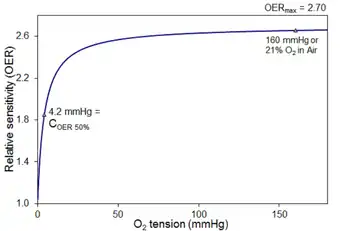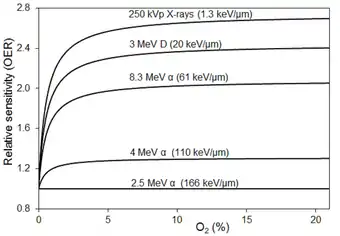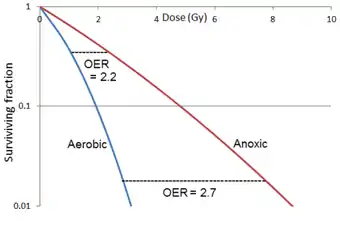Oxygen effect
In biochemistry, the oxygen effect refers to a tendency for increased radiosensitivity of free living cells and organisms in the presence of oxygen than in anoxic or hypoxic conditions, where the oxygen tension is less than 1% of atmospheric pressure (i.e., <1% of 101.3 kPa, 760 mmHg or 760 torr).
Physiology and causes

Explanation of the oxygen effect and relevance to hypoxic tissues
The oxygen effect has particular importance in external beam radiation therapy where the killing of tumour cells with photon and electron beams in well oxygenated regions can be up to three times greater than in a poorly vasculated portion of the tumour.
Besides tumour hypoxia, the oxygen effect is also relevant to hypoxia conditions present in the normal physiology of stem cell niches such as the endosteum adjacent to bone in bone marrow[1] and the epithelium layer of the intestine.[2] In addition, there are non-malignant diseases where oxygenated tissues can become hypoxic such as in stenosed coronary arteries associated with cardiovascular disease.[3]

Historical research on the oxygen effect
Holthusen (1921)[4] first quantified the oxygen effect finding 2.5 to 3.0-fold less hatching eggs of the nematode Ascaris in oxygenated compared to anoxic conditions, which was incorrectly assigned to changes in cell division. However, two years later, Petry (1923)[5] first attributed oxygen tension as affecting ionizing radiation effects on vegetable seeds. Later, the implications of the effects of oxygen on radiotherapy were discussed by Mottram (1936).[6]
A key observation limiting hypotheses to explain the biological mechanisms of the oxygen effect is that the gas nitric oxide is a radiosensitizer with similar effects to oxygen observed in tumour cells.[7] Another important observation is that oxygen must be present at irradiation or within milliseconds afterward for the oxygen effect to take place.[8]
The best known explanation of the oxygen effect is the oxygen fixation hypothesis developed by Alexander in 1962,[9] which posited that radiation-induced non-restorable or "fixed" nuclear DNA lesions are lethal to cells in the presence of diatomic oxygen.[10][11] Recent hypotheses include one based on oxygen-enhanced damage from first principles.[12] Another hypothesis posits that ionizing radiation provokes mitochondria to produce reactive oxygen (and nitrogen species), which are leakage during oxidative phosphorylation that varies with a hyperbolic saturation relationship observed with both the oxygen and nitric oxide effects.[13]

Oxygen Enhancement Ratio and the effect of radiation LET
The oxygen effect is quantified by measuring the radiation sensitivity or Oxygen Enhancement Ratio (OER) of a particular biological effect (e.g., cell death or DNA damage),[14] which is the ratio of doses under pure oxygen and anoxic conditions. Consequently, OER varies from unity in anoxia to a maximum value for 100% oxygen of typically up to three for low ionizing-density-radiation (beta-, gamma-, or x-rays), or so-called low linear energy transfer (LET) radiations.
Radiosensitivity varies most rapidly for oxygen partial pressures below ~1% atmospheric (Fig. 1). Howard-Flanders and Alper (1957)[15] developed a formula for the hyperbolic function of OER and its variation with oxygen concentration, or oxygen pressure in air.
Radiobiologists identified additional characteristics of the oxygen effect that influence radiotherapy practices. They found that the maximum OER value diminishes as the ionizing-density of the radiation increases (Fig. 2), from low-LET to high-LET radiations.[16] The OER is unity irrespective of the oxygen tension for alpha-particles of high-LET around 200 keV/μm. The OER is reduced for low doses as evaluated for cultured mammalian cells exposed to x-rays under aerobic (21% O2, 159 mmHg) and anoxic (nitrogen) conditions.[17] Typical fractionation treatments are daily 2 Gy exposures, as below this dose the so-called 'shoulder' or repair region of the cell survival curve is encroached upon reducing the OER (Fig. 3).
References
- Parmar K, Mauch P, Vergilio JA, Sackstein R, Down JD (2007). "The oxygen fixation hypothesis: a reevaluation". Proceedings of the National Academy of Sciences. 104 (13): 5431–5436. doi:10.1073/pnas.0701152104. PMC 1838452. PMID 17374716.
- Zheng L, Kelly CJ, Colgan SP (2015). "Physiologic hypoxia and oxygen homeostasis in the healthy intestine. A review in the theme: Cellular responses to hypoxia". Am J Physiol Cell Physiol. 309 (6): C350–C360. doi:10.1152/ajpcell.00191.2015. PMC 4572369. PMID 26179603.
- Richardson, RB (2008). "Age-dependent changes in oxygen tension, radiation dose and sensitivity within normal and diseased coronary arteries-Part B: modeling oxygen diffusion into vessel walls". Int J Radiat Biol. 84 (10): 849–857. doi:10.1080/09553000802389645. PMID 18979320. S2CID 24585967.
- Holthusen H (1921). "Beitrage zur Biologie der Strahlenwirkung". Pflügers Archiv. 187: 1–24. doi:10.1007/BF01722061. S2CID 26030155.
- Petry EJ (1923). "Kenntnis der Bedingungen der biologischen Wir kung der Rontgenstrahlen". Biochemische Zeitschrift: 135–353.
- Mottram JC (1936). "Factor of importance in radiosensitiity of tumours". Br J Radiol. 9: 606–614. doi:10.1259/0007-1285-9-105-606.
- Gray LH, Green FO, Hawes CA (1958). "Effect of nitric oxide on the radiosensitivity of tumour cells". Nature. 182 (4640): 952–953. Bibcode:1958Natur.182..952G. doi:10.1038/182952a0. PMID 13590191. S2CID 27573591.
- Howard-Flanders, P, Moore, D (1958). "The time interval after pulsed irradiation within which injury to bacteria can be modified by dissolved oxygen. I. A search for an effect of oxygen 0.02 second after pulsed irradiation". Radiat Res. 9 (4): 422–437. Bibcode:1958RadR....9..422H. doi:10.2307/3570768. JSTOR 3570768. PMID 13591515.
- Alexander P (1962). "On the mode of action of some treatments that influence the radiation sensitivity of cells". Trans N Y Acad Sci. 24: 966–978. doi:10.1111/j.2164-0947.1962.tb01456.x. PMID 14011969.
- Ewing D (1998). "The oxygen fixation hypothesis: a reevaluation". Am J Clin Oncol. 21 (4): 355–361. doi:10.1097/00000421-199808000-00008. PMID 9708633.
- Hall, EJ; Giaccia, AJ (2019). Radiobiology for the Radiologist. Philadelphia, PA: Wolters Kluwer. p. 597. ISBN 978-1-49-633541-8.
- Grimes DR, Partridge M (2015). "A mechanistic investigation of the oxygen fixation hypothesis and oxygen enhancement ratio". Biomedical Physics & Engineering Express. 1 (4): 045209. doi:10.1088/2057-1976/1/4/045209. PMC 4765087. PMID 26925254.
- Richardson RB, Harper ME (2016). "Mitochondrial stress controls the radiosensitivity of the oxygen effect: Implications for radiotherapy". Oncotarget. 7 (16): 21469–21483. doi:10.18632/oncotarget.7412. PMC 5008299. PMID 26894978.
- Thoday JM, Read J (1947). "Effect of oxygen on the frequency of chromosome aberrations produced by X-rays". Nature. 160 (4070): 608. Bibcode:1947Natur.160..608T. doi:10.1038/160608a0. PMID 20271559. S2CID 4068339.
- Howard-Flanders P, Alper T (1957). "The sensitivity of microorganisms to irradiation under controlled gas conditions". Radiat Res. 7 (5): 518–540. Bibcode:1957RadR....7..518H. doi:10.2307/3570400. JSTOR 3570400. PMID 13485393.
- Barendsen GW, Koot CJ, Van Kersen GR, Bewley DK, Field SB, Parnell CJ (1966). "The effect of oxygen on impairment of the proliferative capacity of human cells in culture by ionizing radiations of different LET". Int J Radiat Biol Relat Stud Phys Chem Med. 10 (4): 317–327. doi:10.1080/09553006614550421. PMID 5297012.
- Palcic B, Brosing JW, Skarsgard LD (1982). "Survival measurements at low doses: oxygen enhancement ratio". Br J Cancer. 46 (6): 980–984. doi:10.1038/bjc.1982.312. PMC 2011221. PMID 7150493.